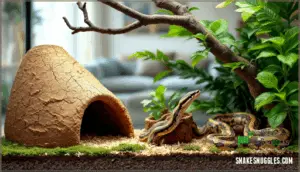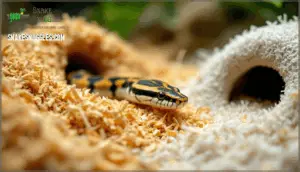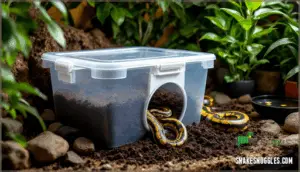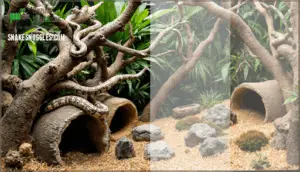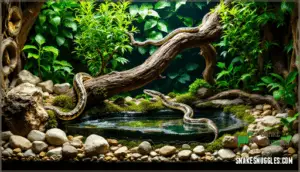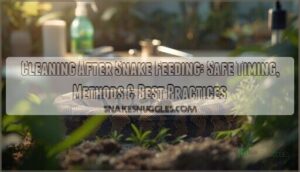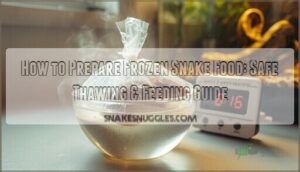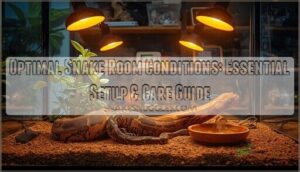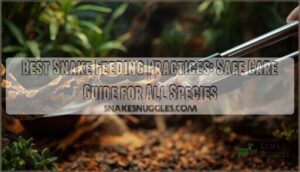This site is supported by our readers. We may earn a commission, at no cost to you, if you purchase through links.
 Most snake owners assume that a clean enclosure with water and heat is enough. But captive snakes confined to static environments show increased hiding behavior and reduced exploratory activity—signs of chronic stress. Your snake’s brain needs challenges just like its body needs proper temperatures.
Most snake owners assume that a clean enclosure with water and heat is enough. But captive snakes confined to static environments show increased hiding behavior and reduced exploratory activity—signs of chronic stress. Your snake’s brain needs challenges just like its body needs proper temperatures.
Studies on enriched reptile habitats reveal measurable improvements in natural behaviors and stress markers. Simple changes to your snake’s environment can transform a sterile box into a space that engages instincts honed over millions of years.
Strategic enrichment ideas for snake enclosure design don’t require expensive equipment or complicated setups—just an understanding of what your snake naturally seeks.
Table Of Contents
Key Takeaways
- Captive snakes need environmental stimulation beyond basic survival requirements, as research shows enriched habitats reduce hiding behavior and increase exploratory activity by nearly 8% while promoting larger brain volumes.
- Effective enrichment combines three types—cognitive challenges like puzzle feeders, sensory stimulation through scent trails and visual contrasts, and physical opportunities including climbing structures and loose substrates for burrowing.
- Regular rotation of enclosure elements every two to three weeks maintains novelty and prevents habituation, keeping snakes mentally engaged without requiring expensive equipment.
- Species-specific enrichment matters because arboreal snakes need vertical climbing structures while fossorial species require deep substrate for tunneling, and most snakes shouldn’t share enrichment activities due to stress and aggression risks.
What is Enrichment for Snakes?
Enrichment means adding value to your snake’s life through activities and environmental changes that promote natural behaviors. It improves mental and physical health by reducing stress and preventing boredom.
Let’s look at what enrichment means and why it matters for captive snakes.
Definition and Purpose of Enrichment
Enrichment turns a basic snake enclosure into a stimulating environment that challenges your pet’s mind and body. The definition of enrichment centers on providing enrichment for snakes through behavioral opportunities that mimic natural conditions.
This means adding value to their daily lives with mental stimulation and physical exercise. The purpose is stress reduction and improved well-being by creating an environment where your snake can express instinctive behaviors.
Benefits for Captive Snakes
Your snake’s quality of life improves dramatically with proper enrichment. Studies show enriched enclosures reduce stress in reptiles by cutting hiding time and inactivity by nearly 8%.
Studies show enriched enclosures reduce stress in reptiles by nearly 8%, dramatically improving your snake’s quality of life
Brain development accelerates too—snakes in stimulating environments develop larger brain volumes than those in bare tanks. Providing enrichment has been shown to increase brain volume.
You’ll see more natural behaviors like climbing and exploring. Activity levels increase as your snake uses vertical space and investigates novel objects. Cognitive function sharpens, helping captive reptile welfare through better problem-solving abilities and reduced anxiety.
Common Types of Enrichment (Cognitive, Sensory, Physical)
Three main types of enrichment work together to keep your snake healthy and engaged.
- Cognitive enrichment challenges your snake’s problem-solving abilities through puzzle feeders and hidden food that stimulate hunting instincts and mental sharpness.
- Sensory enrichment provides visual contrasts, scent trails, and varied textures that activate natural curiosity and exploratory behaviors.
- Physical enrichment includes climbing structures and loose substrates that encourage movement, exercise, and species-specific behavioral needs like burrowing.
Environmental Enrichment Techniques
Your snake’s enclosure isn’t just a box—it’s their entire world. Changing that environment gives them chances to explore and engage with their surroundings.
Here are four proven ways to improve your snake’s habitat and keep their mind sharp.
Rotating and Rearranging Enclosure Decor
Your snake’s enclosure doesn’t need to look the same every time you walk by—changing things up keeps your pet alert and curious. Rearranging hides and branches every few weeks introduces novelty that triggers exploration. This behavioral enrichment mimics natural habitat changes and reduces stress.
| Enrichment Element | Rotation Frequency |
|---|---|
| Hide placements | Every 2-3 weeks |
| Climbing branches | Monthly |
| Decorative plants | Every 3-4 weeks |
| Water bowl location | Every 2 weeks |
| Background items | Monthly |
Watch for increased activity after spatial arrangement changes in your snake enclosure.
Providing Loose and Varied Substrates
Loose substrate transforms a sterile enclosure into a lively environment where your snake can push, tunnel, and engage muscles it rarely uses on flat surfaces. Mixing aspen shavings with coconut fiber creates layers that support natural behaviors like burrowing and digging.
Consider these substrate safety factors for your snake habitat:
- Moisture levels prevent respiratory issues and maintain proper shedding conditions
- Cleaning frequency makes certain bacteria don’t accumulate in dampened areas
- Particle size matters—avoid cedar or pine that release harmful oils
- Depth matters—provide at least 3-4 inches for meaningful digging in your snake enclosure
Creating Dig Boxes and Burrowing Areas
A dedicated dig box acts like a secret escape hatch—a small container filled with deeper substrate where your snake can satisfy its instinct to burrow without disrupting the entire enclosure.
You can use a plastic storage bin with a secure lid. Cut an access hole that matches your snake’s body width. Fill it with six to eight inches of loose substrates like coconut fiber or chemical-free topsoil. Check moisture weekly to prevent mold growth.
Introducing Climbing Structures and Hides
Even snakes that spend most of their lives on the ground benefit from branches and elevated perches that let them stretch upward and survey their territory from a new angle. Arboreal adaptations aren’t just for tree dwellers.
Secure branches between anchor points to create safe climbing structures. Combine these climbing opportunities with multiple hides placed at different heights for complete habitat enrichment.
Use sturdy wood or cork bark for material selection. Test stability before introducing your snake.
Sensory and Cognitive Stimulation Ideas
Your snake’s mind needs exercise just as much as its body does. Sensory and cognitive enrichment draws on your pet’s natural instincts through sight, smell, and problem-solving activities.
Here are proven ways to keep your snake mentally sharp and engaged.
Novel Objects and Visual Contrasts
Snakes process their world through vision just as much as scent, and the right visual cues can spark curiosity and encourage natural exploratory behaviors. Visual contrasts help with size discrimination and pattern recognition. You can introduce novel objects like branches, rocks, or artificial plants that offer different colors and patterns for your snake to investigate.
Try adding items with varied textures and shapes to promote object interaction. Rotate these environmental enrichment elements weekly to maintain novelty and provide ongoing sensory stimulation that keeps your snake mentally engaged.
Scent Trails and Olfactory Enrichment
Your snake’s sense of smell is a powerful tool for hunting and navigation, making scent-based enrichment one of the most effective ways to engage their natural instincts.
Create scent trails by rubbing prey items on branches or hides throughout the enclosure. This prey scenting technique triggers natural musk detection and encourages exploration.
You can also introduce safe natural scents like herbs or leaf litter for olfactory stimulation. Rotate scent introduction regularly to prevent olfactory fatigue and maintain sensory engagement.
Puzzle Feeders and Hidden Food
In the wild, snakes work for every meal—and making your pet forage does more than just fill their stomach. Puzzle feeders and hidden food promote foraging behavior and satisfy hunting instincts while providing an essential cognitive challenge.
Try these snake feeding strategies:
- Hide prey under substrate layers
- Place food inside paper towel rolls
- Create scent enrichment trails leading to meals
- Use commercial puzzle feeders designed for reptiles
- Rotate prey variation and hiding locations
This behavioral enrichment keeps your snake mentally sharp and engaged.
Auditory Stimulation for Curiosity
While snakes don’t rely on hearing the way mammals do, research shows they respond to vibrations and low-frequency sounds—which means strategic auditory enrichment can spark curiosity and encourage natural alertness.
Try playing natural sounds like rustling leaves or gentle rain near your snake’s enclosure. Their vibration sensitivity picks up on these low-frequency stimuli.
This sensory enrichment works well alongside other environmental enrichment and reptile enrichment activities to keep your pet engaged.
Promoting Natural Behaviors and Physical Activity
Your snake needs more than just food and water to thrive. Physical activity and natural behaviors keep them healthy and mentally sharp.
Here’s how you can encourage these essential activities in your snake’s daily routine.
Encouraging Climbing and Exploration
When you give your snake opportunities to climb and explore, you’re tapping into instincts that evolution hardwired over millions of years. Arboreal setups with varied branch thickness let your reptile practice secure climbing while building muscle strength. Even terrestrial species benefit from vertical space and exploration enrichment.
Key climbing opportunities include:
- Horizontal and diagonal branches at different heights for safe weaving movements
- Secure climbing structures anchored firmly to prevent falls or injuries
- Ledges and platforms that create multiple levels for exploration safety
Digging and Burrowing Opportunities
Just as climbing branches satisfy a snake’s vertical instincts, loose substrate unlocks a different set of natural behaviors that many species rely on for security and stress reduction.
Substrate depth matters because your snake needs enough material to burrow effectively. Most species dig tunnels or create hideaways beneath the surface. A snake dig box with varied substrate lets your pet weave through layers and exercise natural instincts.
Burrowing safety requires materials that won’t collapse. Species differences determine ideal substrate types and tunnel complexity.
Safe Supervised Exploration Outside The Enclosure
Beyond the confines of the enclosure, supervised time in a secure room can sharpen your snake’s senses and offer physical exercise that even the best habitat setup can’t fully replicate. Exploration safety requires careful preparation:
- Remove hazards like small gaps or toxic plants
- Monitor temperature to prevent chilling
- Observe behavior for stress signals
- Limit session length based on species tolerance
This supervised exploration for snakes builds confidence and provides enrichment benefits through behavioral observation.
Rotating Activities to Prevent Boredom
Even the most stimulating setup loses its appeal when your snake encounters the same objects day after day, so a regular rotation schedule keeps their environment fresh and engaging. Swap décor every two weeks to maintain novelty and prevent habituation signs like reduced exploration.
This variety benefits mental stimulation and physical exercise. Track your activity schedule to guarantee consistent environmental enrichment. Watch for boredom indicators like lethargy or repetitive pacing in enriching reptile environments.
Creating a Species-Appropriate Enclosure
Creating the right home for your snake starts with knowing where it comes from and what it needs. Different species have different habits based on their natural environments.
Let’s look at how to build an enclosure that matches your snake’s specific needs.
Understanding Your Snake’s Natural History
Your snake’s evolutionary origins shape everything about its needs. Fossil records trace snakes back 167 million years to the Jurassic period. Since then, different snake species have adapted to specific habitats through behavioral ecology and dietary adaptations. Desert species evolved lighter coloration to manage temperature influence. Arboreal snakes developed climbing abilities.
Understanding habitat specialization helps you replicate natural behaviors. Snakes thrive in various environments, including deserts, forests, and grasslands. Research your reptile’s wild environment to design appropriate enrichment that fosters its animal behavior patterns.
Adapting Enrichment to Species Preferences
Each snake species has unique enrichment needs based on its natural history. Arboreal species need vertical structures and climbing branches to express species-appropriate behaviors. Fossorial snakes require deep loose substrate for burrowing and tunneling.
In European zoos, 91% of non-venomous snakes received structural enrichment, but only 42% got sensory enrichment. You should monitor behavioral indicators like increased activity and exploration. Species-specific enrichment encourages natural behaviors and reduces stress.
Dietary preferences also vary—some snakes hunt actively while others ambush prey.
Ball Python-Specific Enrichment Ideas
Ball pythons thrive with enrichment that challenges the outdated myth they’re sedentary "pet rocks." Puzzle feeding techniques like hiding prey or creating scent trails stimulate natural hunting instincts. Adequate enclosure size allows for movement and activity. Rotate these snake enrichment activities regularly to maintain interest and support overall snake care.
You can provide climbing opportunities using sturdy branches at various heights. Ball python enrichment includes interaction sessions for trust-building and exploration.
Monitoring Well-Being and Reducing Stress
You can track animal welfare through consistent observation of stress behavior patterns. Watch for stereotypies like repetitive pacing or weaving that signal poor reptile health.
Physiological indicators include changes in feeding response and shedding quality. Behavioral metrics help you assess enrichment efficacy and adjust your approach.
Regular welfare assessment guarantees your stress reduction strategies support prime snake health and well-being.
Frequently Asked Questions (FAQs)
How often should I change enrichment items?
Rotate items every one to two weeks to maintain novelty and prevent habituation. Watch your snake’s behavioral cues. Some individuals need more frequent changes for proper mental stimulation than others.
What temperature ranges are safe for exploration?
When warmth becomes a weapon—your pet snake needs temperatures between 75-90°F during supervised exploration outside its enclosure. Species variations matter. Monitor your reptile using digital thermometers to prevent thermal burns.
Avoid cold drafts and direct heat sources without safe gradients or proper basking spots.
Can multiple snakes share enrichment activities together?
Most snakes shouldn’t share enrichment activities together. Individual needs vary by species. Resource competition creates stress. Disease transmission poses serious safety concerns.
Group dynamics often lead to aggression in reptiles. Solitary housing favors animal welfare and natural behaviors.
Which substrates are toxic or unsafe for snakes?
Cedar shavings and pine release toxic oils that cause respiratory distress in reptiles. These substrates trigger oil absorption through the skin, and dust inhalation damages lungs. Chemical leaching from treated woods poisons snakes slowly.
Choose safe alternatives for your Snake Enrichment Board to prioritize snake health and care.
How do I know if enrichment causes stress?
Watch for behavior changes and stress signs to gauge your snake’s response. Look for appetite loss, defensive postures, excessive hiding, shedding issues, or reduced activity levels. These indicate the enrichment may be overwhelming rather than providing mental stimulation.
Conclusion
In the wild, a snake might traverse a mile of varied terrain in a single night—encountering new scents, textures, and obstacles that keep its mind sharp. Your enclosure can’t replicate that scale, but it can replicate that principle.
Enrichment ideas for snake enclosure design aren’t optional extras. They’re the difference between survival and thriving. Rotate elements. Challenge instincts. Watch your snake shift from passive resident to active participant in its own space.
- https://www.ixl.com/feedback/vocabularydotcom
- https://www.aza.org/behavior-scientific-advisory-group?locale=en
- https://youtube.com/shorts/2nO8ULsQQEU
- https://www.youtube.com/playlist?list=PLNbZzsRecQ2ac3qvbWHmR2jxsl0B0jUtx
- https://www.animalbehaviorandcognition.org/uploads/journals/26/AB_C_2020_Vol7(1)_Spain_et_al.pdf

